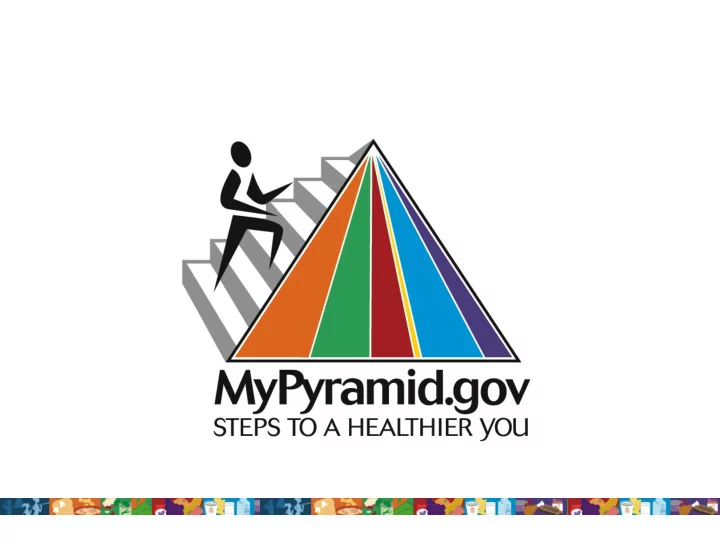

One Size DOESN’T Fit All • Everyone has their own unique pyramid • Recommends specific serving sizes just for you • Find your pyramid
Determine Calorie Needs Estimated Energy Requirements* for males 3400 3200 3000 2800 ACTIVE 2600 2400 Calories 2200 2000 SEDENTARY 1800 1600 1400 1200 1000 3 4 5 6 7 8 9 10 11 12 13 14 15 16 17 18 20 25 30 35 40 45 50 55 60 65 70 75 80 Age *From the National Academy of Sciences, Institute of Medicine Dietary Reference Intakes Macronutrient Report
Get your Pyramid
Learn how much and what to eat for YOUR calorie level at MyPyramid.gov Submit age, Check sex and here for activity more level for a information personalized on food MyPyramid groups & related topics
What Messages does MyPyramid Give?
MyPyramid recommends total amounts rather than “servings” MyPyramid gives more specific guidelines about the types and AMOUNTS of foods to eat than previous Food Guide Pyramid
Food Groups are Color Coded
What Else Does MyPyramid Emphasize? Activity Proportionality Moderation Variety Personalization Gradual Improvement
Message: Physical Activity In the Dietary Guidelines: • Engage in regular physical activity and reduce sedentary activities to promote health, psychological well-being, and a healthy body weight. In MyPyramid graphic: • Steps and person on them symbolize that physical activity should be a part of everyday healthy living.
Message: Moderation In the Dietary Guidelines: • Limit intake of saturated and trans fats, and choose products low in these fats. • Make choices of meat, poultry, dry beans, and milk products that are lean, low-fat, or fat-free. • Choose and prepare foods and beverages with little added sugars or calorie sweeteners. In MyPyramid graphic: • Food group bands narrow from bottom to top suggesting to eat nutrient-dense forms of foods.
Message: Personalization In MyPyramid graphic: • Everyone has their own unique pyramid • One size does NOT fit all • How much you get to eat, depends on your age, gender and activity level
Message: Proportionality In the Dietary Guidelines: • Adopt a balanced eating pattern. – Sufficient amount of fruits and vegetables, – 3 or more ounce equivalents of whole-grain products per day – 3 cup equivalents per day of fat-free or low-fat milk or milk products. In MyPyramid graphic: • Differing widths of the color bands suggest about how much food should be eaten from each group.
Message: Variety In the Dietary Guidelines: • Consume a variety of nutrient-dense foods and beverages within and among the basic food groups. In MyPyramid graphic: • Color bands represent that all food groups are needed each day for health.
Additional Messages in the MyPyramid Graphic Gradual Improvement: • The slogan “Steps to a Healthier You” suggests that improvement should happen in stages, over time.
Discretionary Calories May be used to: • Increase amount of food selected from a food group • Consume foods that are not in the lowest fat form—such as 2% milk or medium-fat meat or items that contain added sugars • Add oil, fat, or sugar to foods • Consume alcohol (for those who consume alcohol)
What is a “serving”? FOOD GUIDE PYRAMID “TYPICAL” AMERICAN SERVINGS PORTIONS ½ cup rice or pasta 1 cup rice or pasta ½ bagel or ½ hamburger bun 1 bagel or 1 hamburger bun 1 chicken leg and thigh ¼ chicken 1 order (½ cup) French fries Large order (3/4 to 1 cup) fries 1 order (½ cup) cooked red beans Big bowl (1 to 2 cups) chili beans 1 cup leafy greens Large green salad (2 cups greens) Source: http://www.fns.usda.gov/tn/tnrockyrun/whatsa.htm
MyPyramid tells you exact amounts of each type of food
Food Groups are Color Coded
MyPyramid: Fruits • Eat the equivalent of 2 cups of fresh, canned or frozen fruits per day (for a 2,000 calorie diet) Note this equivalent: ¼ cup dried fruit = ½ cup fruit
MyPyramid: Dairy products • Consume 3 cups per day of fat-free or low-fat milk or equivalent milk products – Children ages 2 to 8: 2 cups per day – Children ages 9 & up: 3 cups per day Equivalents: • 8 oz. milk • 1½ oz. natural cheese • 1 cup yogurt • 2 oz. processed cheese
MyPyramid: Vegetables • Eat the equivalent of 2½ cups of raw or cooked vegetables per day (for a 2,000 calorie diet) Note this equivalent: 2 cups raw leafy greens = 1 cup of vegetable
MyPyramid: Grains Eat 6 ounce-equivalents (for a 2,000 calorie diet) 3 ounce-equivalents or more of whole-grain products The remaining grains should come from enriched or whole-grain products Equivalents: • 1 slice bread • ½ cup cooked pasta, cooked rice or cooked cereal • 1 cup ready-to-eat cereal
MyPyramid: Meat & beans • Eat 5½ ounce-equivalents (for a 2,000 calorie diet). Choose lean meat and poultry. Vary your choices – more fish, beans, peas, nuts and seeds. Equivalents: • 1 oz. meat, poultry or fish • ¼ cup cooked dry beans or peas • 1 egg • 1 tablespoon peanut butter • ½ oz. of nuts or seeds
Key food group messages from the Dietary Guidelines and MyPyramid: Focus on fruits. Focus on fruits. Vary your veggies. Vary your veggies. Get your calcium- -rich foods. rich foods. Get your calcium Make half your grains whole. Make half your grains whole. Go lean with protein. Go lean with protein. Know the limits on fats, salt, and sugars. Know the limits on fats, salt, and sugars.
Recommend
More recommend